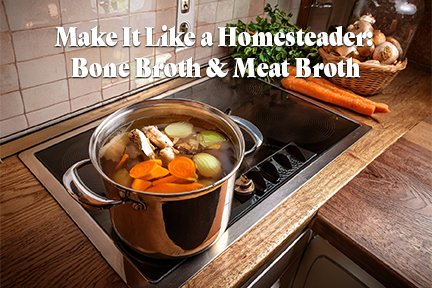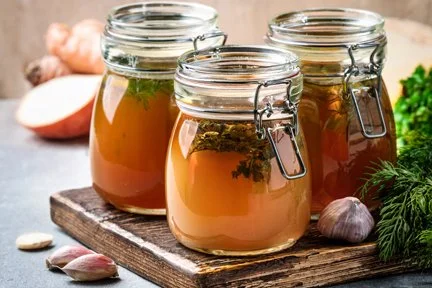Make It Like a Homesteader: Bone Broth & Meat Broth
Real nourishment, right where you are
There was a time when I thought making broth was something reserved for women with chickens out back and hand-thrown pottery stacked neatly in open kitchen shelves. I didn’t grow up with bubbling cauldrons of bones on the stove, and when I moved into my condo, it never occurred to me that one of the most homesteading things I could do might begin in a stock pot on a flat-top range—right in the heart of the city.
But the more I learned about our food system—about the loss of minerals, the rise of chronic illness, the industrial shortcuts that strip away flavor and life—I started to realize that homesteading isn’t defined by acreage.
It’s defined by intention.
And few things carry the weight of intentional nourishment like broth.
What Is Broth—And Why It Matters
Bone broth is more than a trend. It’s a reclamation of something we’ve forgotten in our modern world: that food is meant to heal.
When you simmer bones slowly for hours, you’re pulling minerals like calcium, magnesium, and phosphorus right from the bones and into your broth. You’re drawing out gelatin that soothes the gut and supports skin, joints, and digestion. You’re saying, “Nothing goes to waste.”
When you make meat broth, you’re creating the base of comfort food that sustained families for generations—back when soup wasn’t poured from a can and bouillon wasn’t made in a lab.
Broth is humble. Broth is holy. Broth is slow.
And it’s something you can make—right now, with what you have.
Bone Broth vs. Meat Broth
Let’s break it down:
I make both, depending on what I have. On days when the grocery run gives me a whole chicken, I roast it, enjoy the meat, and freeze the bones for later broth. On weeks when I’m craving soup, I throw a few meaty necks or wings into a pot and make meat broth—quick and ready by dinner.
Sourcing the Good Stuff (Even in the City)
This step matters. Broth pulls nutrients from whatever goes in—so if your bones come from stressed, antibiotic-laced animals, that’s part of your brew.
Here’s how I source, city-style:
Ask butchers for leftover bones—especially marrow, knuckle, or joint bones.
Ethnic markets are treasure troves: look for oxtail, chicken feet, beef neck bones, or soup bones.
Farmers’ markets may offer pasture-raised chicken backs or even turkey necks.
Grocery store hacks: A rotisserie chicken? Save every scrap of it. Even chicken wings from organic brands work great.
Save your scraps: Onion skins, herb stems, celery ends—all these add flavor and depth.
Pro tip: I keep a freezer bag labeled “Broth Bits.” Every time I peel garlic, trim a carrot, or roast a chicken, the scraps go in. When the bag is full, it’s broth day.
Bone Broth Recipe (Slow Simmer or Crockpot)
Ingredients:
2–3 lbs bones (roasted or raw)
2 Tbsp apple cider vinegar
1 onion, quartered (skin on)
2 carrots, chopped
2 celery stalks, chopped
3 cloves garlic
1 bay leaf
10–12 cups filtered water
Optional: rosemary, thyme, parsley stems
Instructions:
Place bones and veggies in a stock pot or slow cooker.
Add vinegar and cold water to cover. Let sit 30 mins.
Bring to boil, skim foam, then reduce to a low simmer.
Simmer 12–24 hours for chicken; 24–48 for beef.
Strain and store in glass jars. Refrigerate up to 5 days or freeze.
🕯️ When it cools, it should jiggle like soft jelly—that’s the good stuff.
Meat Broth Recipe (Faster + Flavorful)
Ingredients:
2–3 lbs meaty bones (like chicken wings or beef shank)
1 onion, chopped
2 carrots, chopped
2 celery stalks, chopped
Salt to taste
10 cups water
Instructions:
Brown meat in a heavy pot (optional but adds flavor).
Add chopped veggies and cover with water.
Bring to boil, skim, then reduce heat.
Simmer 2–6 hours depending on the meat.
Strain and use immediately or store.
I love this one for soups, risottos, and even cooking rice. It’s real flavor—no cubes, powders, or MSG.
Why This Matters (And Why We Keep Doing It)
If you’re anything like me, you long for something deeper than the drive-thru.
You’re tired of reading ingredient lists with words you can’t pronounce. You want to know your food, bless your table, and build a life that nourishes not just your body but your family, your values, and your spirit.
You may not have a farm (yet). But you can simmer what’s sacred.
This is how we start reclaiming the old paths:
With broth on the stove.
With something humble that heals.
Related Posts to Explore
Want to keep this post?
Includes printable recipes, a sourcing checklist, and a simmer-time cheat sheet for your fridge.



